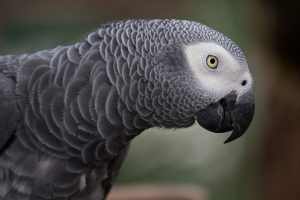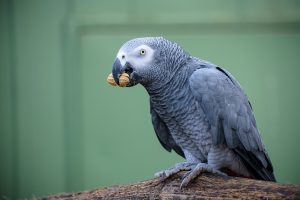A close friendship with a parrot could be one of the most fulfilling experiences in a person’s life. Choosing between the hilarious Cockatiel and the brilliant African Grey can be tough.
Whether you’re brand new to the idea of owning a parrot or have years of experience with them already, you might be curious about the differences in temperament and maintenance requirements between the two.
The mental and physical distinctions between the two are striking. Each species has unique needs that must be met in order to thrive. Both species are wonderful friends and bring their owners much joy, but you may find that one is more suitable to your personality. Which one will it be, then?
If you are wondering which one to choose between two, African Grey Vs Cockatiel, then read on to discover their key similarities and differences.
A Table of Comparison between African Grey VS Cockatoo
| Characteristic | African Grey | Cockatiel |
| Size | 13-15 inches | 12 inches |
| Habitat | African greys are found throughout the lowland rainforests in western and central Africa. | Cockatiels are native to Australia, where they are found largely in the arid or semi-arid country but always close to water |
| Price | $500–$4,000 | $80 to $250 |
| Life Span | 25+ years | 10+ years |
| Dander | Yes | Yes |
| Weight | 400gms (14 ounces) | 85-90gms (3 ounces) |
| Grooming | Relatively bigger than Cockatiels hence more grooming is required. | Relatively smaller compared to African greys hence less grooming is required |
African Grey VS Cockatiel: Lifespan

On average, African Greys can live as long as 25 years or more, which is more than one-fourth of a century!
Again, Cockatiels also live for many years, which is about 10 or more years to be exact. However, it is quite lower than the lifespan of African Greys.
Therefore, both bird species live longer than typical pets such as dogs and cats. But African Greys clearly live 10 to 15 years longer than Cockatiels and would be the best bet for you if you want your pet to live longer.
African Grey VS Cockatiel: Size & Weight
In terms of weight (the size is more or less the same), there is a clearance between the two species and is definitely one of the key factors which will help you determine which bird is a more suitable pet for you.
African Greys weigh around 400gms (14 ounces) and stand as tall as 13-15 inches. While an average Cockatiel weighs between 85-90gms (or 3 ounces) and its height is about 12 inches. Hence, even though they have similar height, African Greys are relatively much heavier.
So if you are looking for a big and heavy bird as your companion, then the Greys might be a better option for you. But if you are uncomfortable with heavyweight birds then the weightless Cockatiel may be the better choice.
African Grey VS Cockatiel: Price
African Greys are considered exotic animals and hence it is no surprise that it is quite expensive. The exact price of the bird will depend on several factors such as sub-species, age, gender, colour and markings etc., but in general, the price of an African Grey will be around $500–$4,000.
On the other hand, cockatiels are quite affordable as for the standard cockatiel, you are likely to pay around $150. However, prices can vary from $80 to $250 and depend upon several factors such as the breed, age, mutation, health, and personality of the bird.
So if you are on a tight budget, then clearly cockatiels are your best option. However, if you are willing to spend money to have an exotic bird as your pet, then look no further, as African Greys may be the best for you.
African Grey VS Cockatiel: Characteristics & Habits
| African Grey | Cockatiel |
| The majority of bird keepers think that a grey should only be kept by an expert bird enthusiast. They are highly intelligent parrots, yet despite their intelligence, they can be rather temperamental and demanding. They are extremely sensitive, which can lead to behavioral issues, in addition to their other positive traits, which include being charming and intellectual. A sensitive grey that is fearful of change could become agitated by even the smallest variation in a routine if it is not followed exactly. Among other unpleasant habits, they are sometimes vulnerable to feather plucking and gnawing.
African greys aren’t “cuddle bugs,” but they are social parrots who require a lot of human interaction. Although some people don’t mind a little cuddling, they do not enjoy excessive physical contact and will only tolerate light head scratches and light stroking. Every bird has unique preferences and tastes. Even if the grey is socialized with from the beginning by every member of the household, it still has the potential to become a “one-person bird.” |
Because they are smart, cockatiels may gradually learn a wide range of tricks. They’re cunning little birds who can whistle, wave, and ring bells, and they’ll like a new challenge. A good number of cockatiels may even keep themselves entertained for extended periods of time by chatting with the “other bird” reflected in a mirror.
Although cockatiels are often peaceful, an untrained bird has the potential to bite. Moreover, by ignoring inappropriate behavior, as these birds seek to please, you can stop negative habits from developing at a young age. However, never scold an African Grey, as doing so could make it fearful of people. Hence, reward positive behavior and ignore negative behavior. These chirping tiny creatures are pleasant and warmhearted, and they love to be petted and cuddled. However, I t ‘s possible that they’re not always in the mood for a hug. But usually, they can’t help but be attracted to you and will be delighted to actually meet you in person. |
African Grey VS Cockatiel: Diet & Nutrition

| African Grey | Cockatiel |
| The majority of an African grey parrot’s diet consists of bird pellets, fruits, nuts, and occasional seeds. You can feed fresh fruits and vegetables as well.
You can feed fresh fruits and vegetables as well. An African grey parrot requires a high-quality, nutritionally sound diet. Pick Psittacidae-specific mixes that are sold by breeders and specialty shops. Commercial seed mixtures may work for short periods of time, but they frequently include too much fat. African Greys will probably choose the seeds he likes, so over time, they may gain weight and develop nutritional deficiencies. Add a mineral stone to his diet to complement it. This will provide your bird with a source of calcium and other minerals that are necessary for its overall health and well-being. Additionally, be sure to wash the eating bowls with fresh water every day. Then, once a week, you have to add a vitamin supplement to the bird’s water in order to prevent the bird from developing any deficiencies and to keep its feathers looking beautiful. |
As a Cockatiel owner, you must frequently feed them pre-made diets. These foods will primarily consist of seeds. The majority of these seeds are rather fatty.
Obesity and fatty liver syndrome are triggered in cockatiels when they are fed a diet high in seeds. For cockatiels, a variety of pellets is essential. The pellets, however, must be selected based on the bird’s age. Pellets should make up 75–80 percent of their diet, ideally. Fresh fruits and vegetables can make up the remainder of the diet. Additionally, seeds make up 1% to 2% of the daily diet. Moreover, Cockatiels need to drink a lot of water all day long. However, the liquid from food left in their mouths may become contaminated by their saliva. As a precaution, the water should be changed at least twice daily. |
African Grey VS Cockatiel: Speech Training
| African Grey | Cockatiel |
| Grey parrots are notorious for constantly mimicking the sounds they hear around them.
Captive African grey parrots have been observed expressing conversational skills, which include the precise and properly understood use of human language. A Grey parrot can be taught to talk by having regular conversations with its owner using the same words. Your pet can learn your language and start mimicking you with ease if you do this. Always treat others with kindness, gentleness, and care. Never rush or try to push something. When your bird is ready and feels secure doing so, he will begin communicating with you. If you continue to put too much pressure, on the Grey parrot will stop responding properly, which will have a negative impact on your relationship. |
Whistling is the more common form of communication for cockatiels. Cockatiels are intelligent birds that can learn to speak a few words or phrases. Male cockatiels are more likely to communicate than female cockatiels.
But if all they do is make noises and whistle at you, it’s possible that you won’t understand what they’re trying to say to you. The following is a list of sound and vocalization patterns that you should be familiar with: The Scream Whistle – is a type of noise made by cockatiels that resemble a combination of a shriek and a whistle. The majority of cockatiel owners do not find this call to be entertaining or enjoyable, yet it is a crucial communication technique that the cockatiel uses when they are feeling lonely, terrified, or thrilled. The Unusual Whistle – Cockatiels who enjoy whistling will pick up a variety of whistles to imitate, including the catcall and melodies from popular TV shows. The Hissing Sound – Any cockatiels, when they become frightened or feel threatened for some reason, may emit a hissing sound that warns others around them that they are ready to strike with a bite or nip. This sound can be heard while the cockatiel is making eye contact with another creature. |
African Grey VS Cockatiel: Health Care

| African Grey | Cockatiel |
| The ideal temperature range for an African Grey parrot is between 70 and 80 degrees Fahrenheit, therefore you have to maintain that temperature in the room they are kept in.
It’s important to provide a continuous supply of toys for these birds, as boredom can lead to aggressive behavior. You should do what you can to ensure they have a restful night. Always make sure the light source within their cage is blocked. Their environment is dark and quiet, making it perfect for sleeping at night. These parrots keep getting bigger beaks in most cases. In order to prevent overgrowth, it is necessary for them to chew on material that is fibrous and coarse. In the wild, this is not a problem, but domesticated pets require artificially-produced roughage to satisfy their natural chewing needs. Beak-wearing should be encouraged in a natural way, so provide plenty of wooden chew toys and perches for your pet. |
The provision of a meal rich in essential nutrients is of the utmost importance to the general health and happiness of a cockatiel.
In addition to the previously mentioned requirements, they have to undergo a comprehensive checkup at the veterinary clinic as soon as they are adopted. Even if your cockatiel has previously been vaccinated, it is still important to take it in for a checkup at the veterinarian once a year. There is a possibility that the feces, blood, and other bodily fluids will be tested in the laboratory by the veterinarian. If for any reason your parrot is found to be sick in any manner, you will be able to discover any issues, if there are any, at the earliest possible stage, take the necessary precautions for its care, or take it back to the store where you bought it.
|
African Grey VS Cockatiel: Colours & Markings
| African Grey | Cockatiel |
| You might not be able to tell from looking at it, but the African grey parrot’s feathers have a lot more variation and complexity than you might think it has.
The feathers of a grey parrot are not all the same shade of grey, contrary to popular belief. Instead, the bird’s upper coat is a brighter, silverier grey than its undercoat, which is darker towards the bird’s head and wings. Additionally, there are white spots and undertones in the head feathers. There are a few more flashes of color as well, including brilliant yellow eyes, a black bill, and vivid red tail feathers. In addition, mutations can occasionally cause the coloration of a parrot’s feathers to be red, blue, brown, or albino. There have been efforts made by certain breeders to increase the amount of red in African grey parrots. They were successful in their studies since some baby parrots now have red or pink feathers instead of grey ones when they are born. On top of that, due to the extreme rarity of these specimens, buyers typically have to pay exorbitant amounts for them. Additionally, grey mutations happen spontaneously in the wild, such as the Blue Ino (which is completely white), the Incomplete Ino (which only has a little coloration), and the Blue varietals. |
The chest and abdomen of a normal cockatiel are lighter in coloration than the rear of the bird, which has an overall medium-grey body coloration. There is a wash of yellow or white on the face and crest, and the edges of the wings have a white border around them. There are noticeable spherical cheek patches that have a vibrant orange coloration on the cheeks. The coloring of male cockatiels is typically more vibrant, whilst the coloring of females is typically more subtle or lighter.
There are two extremely exceptional color variations that can happen in wild cockatiels: Melanistic birds are those that create a greater quantity of dark pigments, which gives them the appearance of being very dark grey or even black, despite the fact that they may still have white patches on their wings. Albino is an uncommon genetic variant that causes the bird to be completely white or creamy in color, and it may have very faint yellow undertones. The albino status of the bird can be recognized from its whitish legs and its crimson eyes. Aviculturists and others who breed birds as pets want to breed cockatiels because they may purposefully encourage their offbeat coloring. Emerald, creamface, pastelface, whiteface, and yellow cheek cockatiels are just some of the color variations that may be found in pet cockatiels. Other color variations include pastelface, whiteface, and whiteface creamface. The coloring of males and females can be used to differentiate between them. These distinctions are not always easy to make, particularly in younger birds or birds still developing their adult feathers. Consider using genetic testing for a conclusive determination of gender. |
Conclusion
Both African Greys and Cockatiels are amazing birds, but there is a significant difference between them, as the Greys are very rare and exotic birds while Cockatiels are relatively very common and can be seen in many households.
Even though Cockatiels are quite common, one must not forget that cockatiels are much more trainable and easier to take care of than the big and loud Greys, not to mention Cockatiels are very affordable. Again, African Greys can be very affectionate and can become life-long companions (as they live longer).
Nevertheless, we have provided you with a detailed review of African Greys vs Cockatiels, so it’s up to you to analyze important factors such as price, personality, size & weight, life span, etc., and choose the right bird for yourself.
Related:

Hi, I’m Regina Rios. Just another bird lover who loves to share knowledge from personal experience. I’ve grown up with pet birds since childhood as my mommy also loves birds. As I can’t pet many birds in open air in my house as my mom does; I created my first bird cage on my rooftop using wood, copper wire, and a metal shed in 2018 and start collecting pet birds. Now, I have so many pet birds such as Macaws, Parrot, Cockatiel, Parakeet, and others. Not only that, if I see natural birds are injured I keep them in my house until they get well. Now, my hobby becomes my income source as my home birds have babies and I sell them to birds lover like mine. I’ve created this blog to inspire others bird owners by sharing my personal knowledge. Good Luck!


